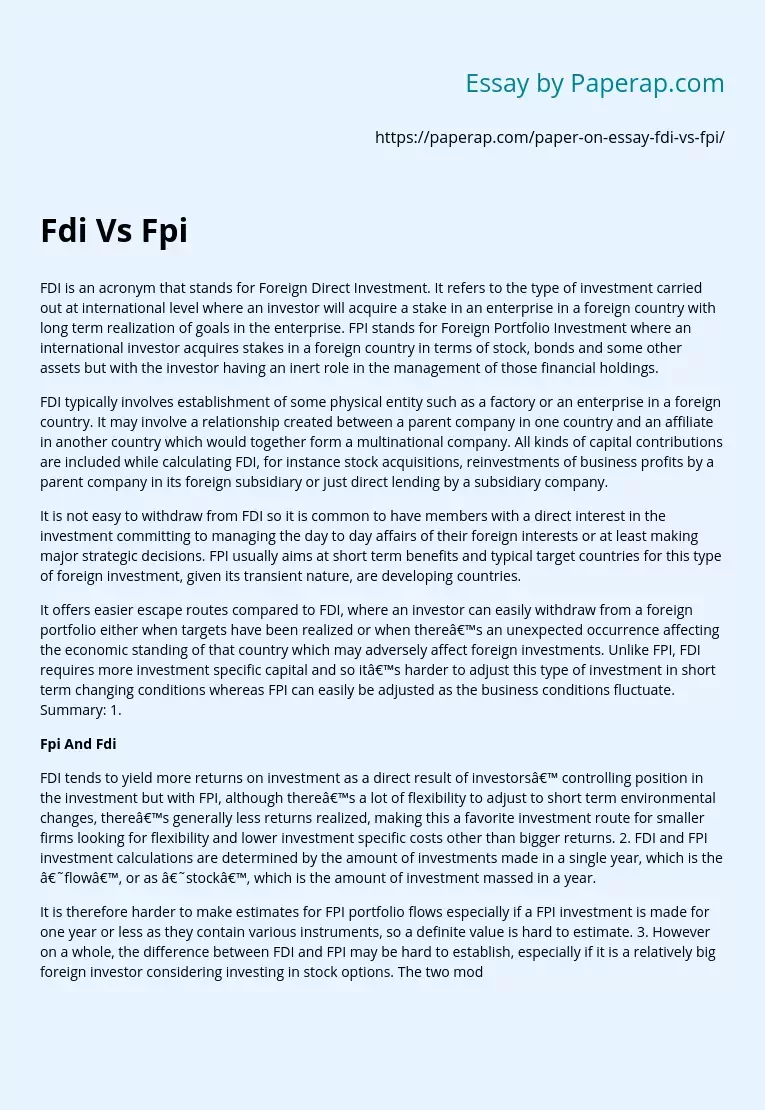Fdi Vs Fpi Essay
FDI is an acronym that stands for Foreign Direct Investment. It refers to the type of investment carried out at international level where an investor will acquire a stake in an enterprise in a foreign country with long term realization of goals in the enterprise. FPI stands for Foreign Portfolio Investment where an international investor acquires stakes in a foreign country in terms of stock, bonds and some other assets but with the investor having an inert role in the management of those financial holdings.
FDI typically involves establishment of some physical entity such as a factory or an enterprise in a foreign country. It may involve a relationship created between a parent company in one country and an affiliate in another country which would together form a multinational company. All kinds of capital contributions are included while calculating FDI, for instance stock acquisitions, reinvestments of business profits by a parent company in its foreign subsidiary or just direct lending by a subsidiary company.
It is not easy to withdraw from FDI so it is common to have members with a direct interest in the investment committing to managing the day to day affairs of their foreign interests or at least making major strategic decisions. FPI usually aims at short term benefits and typical target countries for this type of foreign investment, given its transient nature, are developing countries.
It offers easier escape routes compared to FDI, where an investor can easily withdraw from a foreign portfolio either when targets have been realized or when there’s an unexpected occurrence affecting the economic standing of that country which may adversely affect foreign investments.
Unlike FPI, FDI requires more investment specific capital and so it’s harder to adjust this type of investment in short term changing conditions whereas FPI can easily be adjusted as the business conditions fluctuate. Summary: 1.
Fpi And Fdi
FDI tends to yield more returns on investment as a direct result of investors’ controlling position in the investment but with FPI, although there’s a lot of flexibility to adjust to short term environmental changes, there’s generally less returns realized, making this a favorite investment route for smaller firms looking for flexibility and lower investment specific costs other than bigger returns. 2. FDI and FPI investment calculations are determined by the amount of investments made in a single year, which is the ‘flow’, or as ‘stock’, which is the amount of investment massed in a year.
It is therefore harder to make estimates for FPI portfolio flows especially if a FPI investment is made for one year or less as they contain various instruments, so a definite value is hard to estimate. 3. However on a whole, the difference between FDI and FPI may be hard to establish, especially if it is a relatively big foreign investor considering investing in stock options. The two models coincide in part with each other in this case and it may go down to choosing between flexibility and returns on investment.
Fdi Vs Fpi Essay. (2019, Dec 05). Retrieved from https://paperap.com/paper-on-essay-fdi-vs-fpi/

